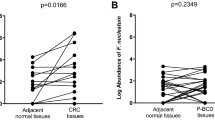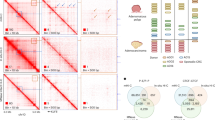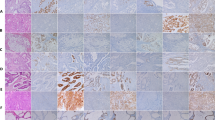Abstract
‘de novo’ carcinogenesis has been advocated besides ‘adenoma carcinoma sequence’ as another dominant pathway leading to colorectal carcinoma. Our recent study has demonstrated that the distribution of brain (fetal)-type glycogen phosphorylase (BGP) positive foci (BGP foci) has a close relationship with the location of ‘de novo’ carcinoma. The aims of the present study are to investigate genetic alteration in the BGP foci and to characterize them in the ‘de novo’ carcinogenesis. 17 colorectal carcinomas without any adenoma component expressing both immunoreactive p53 and BGP protein were selected from 96 resected specimens from our previous study. Further investigations to examine the proliferating cell nuclear antigen (PCNA)-labelling index, and the p53 and the codon 12 of K-ras mutation using the polymerase chain reaction-single strand conformation polymorphism were performed in the BGP foci, BGP negative mucosa and carcinoma. The BGP foci were observed sporadically in the transitional mucosa adjacent to the carcinoma in all cases. The PCNA labelling index in the BGP foci was significantly higher than that in the BGP negative mucosa (P< 0.001). p53 mutations were observed in 8 carcinomas, but no K-ras mutation was detected. Interestingly, although none of the overexpressions of p53 protein was detected immunohistochemically in the BGP positive foci, the p53 gene frequently (41.2% of the BGP foci tested) mutated in spite of no K-ras mutation. The present study demonstrates potentially premalignant foci in the colorectal transitional mucosa with frequent p53 gene mutation. It is suggested that BGP foci are promising candidates for the further investigation of ‘de novo’ colorectal carcinogenesis. © 2001 Cancer Research Campaign http://www.bjcancer.com
Similar content being viewed by others
Article PDF
Change history
16 November 2011
This paper was modified 12 months after initial publication to switch to Creative Commons licence terms, as noted at publication
References
Aoki T, Takeda S, Yanagisawa A, Kato Y, Ajioka Y, Watanabe H and Nakamura Y (1994) APC and p53 mutations in de novo colorectal adenocarcinomas. Hum Mutat 3: 342–346
Baker SJ, Preisinger AC and Jessup M (1990) p53 gene mutations occur in combination with 17p allelic deletions as late events in colorectal tumorigenesis. Cancer Res 50: 7717–7722
Bird RP (1987) Observation and quantification of aberrant crypts in the murine colon treated with a colon carcinogen. Cancer Lett 37: 147–151
Brito MJ, Filipe MI and Morris RW (1992) Cell proliferation study on gastric carcinoma and non-involved gastric mucosa using a bromodeoxyuridine (BrdU) labeling technique. Eur J Cancer Prev 1: 429–435
Buchman VL, Chumakov PM, Nikkina NN, Samarina PP and Georgiev GP (1988) A variation in the structure of the protein-coding of the human p53 gene. Gene 70: 245–252
Cori CF and Cori GT (1936) Mechanism and formation of hexosemonophosphate in muscle and isolation of a new phosphate ester. Proc Soc Exp Biol Med 34: 702–712
Davis CH, Schliselfeld LH, Wolf DP, Leavitt CA and Krebs EG (1967) Interrelationships among glycogen phosphorylase isozymes. J Biol Chem 242: 4824–4833
Dunn JM, Hastrich DJ, Newcomb P, Webb JC, Maitland NJ and Farndon JR (1994) Correlation between p53 mutations and antibody staining in breast carcinoma. Br J Surg 81: 1410–1412
Fearon ER and Jones PA (1992) Progressing toward a molecular description of colorectal cancer development. FASEB J 6: 2783–2790
Fearon ER and Vogelstein B (1990) A genetic model for colorectal Tumorigenesis. Cell 61: 759–767
Filipe MI and Cooke KB (1974) Changes in composition of mucin in the mucosa adjacent to carcinoma of the colon as compared with the normal: a biochemical investigation. J Clin Pathol 27: 315–318
Gelinas RP, Froman BE, McElroy F, Tait RC and Gorin FA (1989) Human brain glycogen phosphorylase: characterization of fetal cDNA and genomic sequence. Mol Brain Res 6: 177–185
Greenblatt MS, Bennett WP, Hollstein M and Harris CC (1994) Mutations in the p53 tumor suppressor gene: clues to cancer etiology and molecular pathogenesis. Cancer Res 54: 4855–4878
Hollstein M, Sidransky D, Vogelstein B and Harris CC (1991) p53 mutations in human cancers. Science 253: 49–53
Ignacio PC, Baldwin BA, Vijayan VK, Tait RC and Gorin FA (1990) Brain isozyme of glycogen phosphorylase: immunohistochemical localization within the central nervous system. Brain Res 529: 42–49
Jordanova A, Kalaydjieva L, Savov A, Claustres M, Schwarz M, Estivill X, Angelicheva D, Haworth A, Casals T and Kremensky I (1997) SSCP analysis: a blind sensitivity trial. Human Mutat 10: 65–70
Krebs EG and Fisher EH (1956) The phosphorylase b to be a converting enzyme of rabbit skeletal muscle. Biochem Biophys Acta 20: 150
Kuramoto S and Oohara T (1988) Minute cancers arising de novo in the human large intestine. Cancer 61: 829–834
Levine AJ, Perry ME, Chang A, Silver A, Dittmer D, Wu M and Welsh D (1994) The role of the p53 suppressor gene in tumorigenesis. The 1993 Walter Hubert Lecture. Br J Cancer 69: 409–416
Lisboa BW, Vogtlander S, Gilster T, Riethdorf L, Milde-Langosch K and Loning T (1997) Molecular and immunohistochemical analysis of p53 mutations in scrapings and tissue from preinvasive and invasive breast cancer. Virchows Archiv 431: 375–381
Lohmann D, Ruhri C, Schmitt M, Graeff H and Hofler H (1993) Accumulation of p53 protein as an indicator for p53 gene mutation in breast cancer. Occurrence of false-positives and false-negatives. Diagnostic Mol Pathol 1: 36–41
Matsuzaki H, Shimada S, Uno K, Tsuruta J and Ogawa M (1998) Novel subtyping of intestinal metaplasia in the human stomach: brain-type glycogen phosphorylase expression in the proliferative zone and its relationship with carcinogenesis. Am J Clin Pathol 109: 181–189
Minamoto T, Sawaguchi K, Mai M, Yamashita N, Sugimura T and Esumi H (1994) Infrequent K-ras activation in superficial-type(flat) colorectal adenomas and adenocarcinomas. Cancer Res 54: 2841–2844
Ming SC, Goldman H and Freiman DG (1967) Intestinal metaplasia and histogenesis of carcinoma in human stomach. Cancer 20: 1418–1429
Morson BC (1974) The polyp-cancer sequence in the large bowel. Proc R Soc Med 67: 451–457
Mueller J, Mueller E, Hoepner I, Jutting J, Bethke B, Stolte M and Hofler H (1996) Expression of bcl-2 and p53 in de novo and ex-adenoma colon carcinoma: a comparative immunohistochemical study. J Pathol 180: 259–265
Nagayo T (1975) Microscopical cancer of the stomach; a study on histogenesis of gastric carcinoma. Int J Cancer 16: 52–60
Nakano K, Hwang P and Fletterick RJ (1986) Complete cDNA sequence for rabbit muscle glycogen phosphorylase. FEBS Lett 204: 283–287
Newgard CB, Littman DR, Genderen CV, Smith M and Fletterick RJ (1988) Human brain glycogen phosphorylase. J Biol Chem 263: 3850–3857
Newgard CB, Hwang PK and Fletterick RJ (1989) The family of glycogen phosphorylase: structure and function. Crit Rev Biochem Mol Biol 24: 69–99
Oohara T, Tohma H, Takezoe K, Ukawa S, Johjima Y, Asakura R, Ano G and Kurosawa H (1982) Minute gastric cancers less than 5 mm in diameter. Cancer 50: 801–810
Pretlow TP, Barrow BJ, Ashton WS, O'Riordan MA, Pretlow TG, Jurcisek JA and Stellato TA (1991) Aberrant crypts: putative preneoplastic foci in human colonic mucosa. Cancer Res 51: 564–567
Pretlow TP, Brasitus TA, Fulton NC, Cheyer C and Kaplan EL (1993) K-ras mutations in putative preneoplastic lesions in human colon:. J Natl Cancer Inst 85: 2004–2007
Rembacken BJ, Fujii T, Cairn A, Dixon MF, Yoshida S, Chalmers DM and Axon ART (2000) Flat and depressed colonic neoplasms: prospective study of 1000 colonoscopies in the UK. Lancet 355: 1211–1214
Sambrook J, Fitsch EF and Maniatis T (1989) Molecular cloning. In a laboratory Manual. Cold Spring Harbor Laboratory Press, New York.
Sato K, Morris HP and Weinhouse S (1972) Phosphorylase: a new isozyme in rat hepatic tumors and fetal liver. Science 178: 879–881
Shamsuddin AM, Kato Y, Kunishima N, Sugano H and Trump B (1985) Carcinoma in situ in non-polypoid mucosa of the large intestine. Cancer 56: 2849–2854
Shi SR, Key ME and Kalra KL (1991) Antigen retrieval in formalin-fixed, paraffin-embedded tissues. An enhancement method for immunohistochemical staining based on microwave oven heating of tissue sections. J Histochem Cytochem 39: 741–748
Shiao YH, Rugge M, Correa P, Lehmann HP and Scheer WD (1994) p53 alteration in gastric precancerous lesions. Am J Pathol 144: 511–517
Shimada S, Maeno M, Misumi A and Akagi M (1984) Histochemical study of phosphorylase in proliferating cells of intestinal metaplasia and carcinoma of the human stomach. Scand J Gastroenterol 19: 965–970
Shimada S, Maeno M, Akagi M, Hatayama I, Sato T and Sato K (1986) Immunohistochemical detection of glycogen phosphorylase isoenzymes in rat and human tissues. Histochem J 18: 334–338
Shimada S, Maeno M, Misumi A, Takano S and Akagi M (1987) Antigen reversion of glycogen phosphorylase isoenzyme in carcinoma and proliferative zone of intestinal metaplasia of the human stomach. Gastroenterology 93: 35–40
Shimada S, Honmyo U, Yagi Y, Ikeda T, Yokota T and Ogawa M (1992) Expression of glycogen phosphorylase activity in minute gastric carcinoma. Am J Gastroenterol 87: 1230–1231
Shimada S, Tashima S, Yamaguchi K, Matsuzaki H and Ogawa M (1999) Carcinogenesis of intestinal-type gastric cancer and colorectal cancer is commonly accompanied by expression of brain (fetal)-type glycogenphosphorylase. J Exp Clin Cancer Res 18: 111–118
Shimoda T, Ikegami M, Fujisaki J, Matsui T, Aizawa S and Ishikawa E (1989) Early colorectal carcinoma with special reference to its development de novo. Cancer 64: 1138–1146
Shivapurkar N, Huang L, Ruggeri B, Swalsky PA, Bakker A, Finkelstein S, Frost A and Silverberg (1997) K-ras and p53 mutations in aberrant crypt foci and colonic tumors from colon cancer patients. Cancer Lett 115: 39–46
Tashima S, Shimada S, Matsuzaki H, Yamaguchi K, Tsuruta J and Ogawa M (2000) Expression of brain-type glycogen phosphorylase is a potentially novel early biomarker in the carcinogenesis of human colorectal carcinomas. Am J Gastroenterol 95: 255–263
Umetani N, Sasaki S, Watanabe T, Matsuda K and Muto T (2000) Involvement of APC and K-ras mutation in non-polypoid colorectal tumorigenesis. Br J Cancer 82: 9–15
Wang O, Gao H, Chen Y, Wang Y, He J and Jin C (1992) Biopathologic characteristics of DNA content in crypt cells of transitional mucosa adjacent to carcinomas of the rectum and rectosigmoid. Dis Colon Rectum 35: 670–675
Vogelstein B, Fearon ER, Hamilton SR, Kern SE, Preisinger AC, Leppert M, Nakamura Y, White R, Smits AM and Bos JL (1988) Genetic alterations during colorectal-tumor development. N Eng J Med 319: 525–532
Yamagata S, Muto T, Uchida Y, Masaki T, Sawada T, Tsuno N and Hirooka T (1994) Lower incidence of K-ras codon 12 mutation in flat colorectal adenomas than in polypoid adenomas. Jpn J Cancer Res 85: 147–151
Zhang H, Nordenskjold B, Dufmats M, Soderkvist P and Sun XF (1998) K-ras mutations in colorectal adenocarcinomas and neighbouring transitional mucosa. Eur J Cancer 34: 2053–2057
Author information
Authors and Affiliations
Rights and permissions
From twelve months after its original publication, this work is licensed under the Creative Commons Attribution-NonCommercial-Share Alike 3.0 Unported License. To view a copy of this license, visit http://creativecommons.org/licenses/by-nc-sa/3.0/
About this article
Cite this article
Shimada, S., Shiomori, K., Tashima, S. et al. Frequent p53 mutation in brain (fetal)-type glycogen phosphorylase positive foci adjacent to human ‘de novo’ colorectal carcinomas. Br J Cancer 84, 1497–1504 (2001). https://doi.org/10.1054/bjoc.2001.1824
Received:
Revised:
Accepted:
Published:
Issue date:
DOI: https://doi.org/10.1054/bjoc.2001.1824



